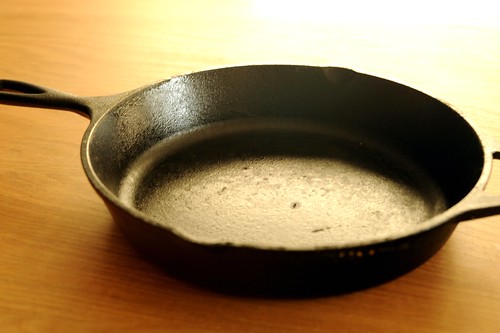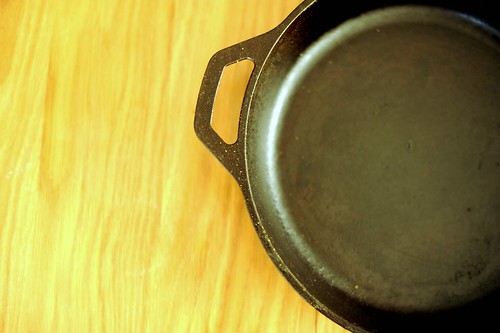Cast iron pans elicit as much fear as they do fervor. For every cook out there who swears by their cast iron skillet, there’s a cook out there who is petrified to use it. I asked a few of my friends and family what made them resist the siren call of cast iron and they all pointed to the same anxiety. They were afraid of its upkeep, which admittedly at first, can seem daunting. But with a few simple rules, you can maintain your cast iron indefinitely and even pass it on to your children or grandchildren. Personally, I’d be pretty excited to get one from either my mom or my grandmother, but I just learned, much to my horror, that their maintenance of it was incorrect (hence them having issues with it). And so, allow me to share a few tips with you about cooking in, caring for, maintaining, and reseasoning your cast iron skillets.
A properly seasoned cast iron will develop a non-stick like coating and will cook your food to perfection. That incredible heat retention and distribution will deliver magnificent results. There’s a reason that cast iron cookware has withstood the test of time. What could be simpler?
1. Warm It Up, Chris*: When warming your cast iron, start with a low heat setting first and gradually increase. Don’t just place the pan on high heat, or place it in the hot oven (warm it inside the oven as it warms).
2. Cooking: When cooking in your cast iron, try not to cook foods with high acid content like tomatoes – it can damage the seasoning and also impart a metallic taste to your food. Stick to regular frying, sauteeing, and whatnot. If you want to bake with your cast iron, make sure it’s an older well-seasoned pan. New pans should be used only for frying to get more seasoned.
3. Don’t Be So Cold:After cooking, please don’t try to cool your pan by thrusting it in cold water – you can actually crack the pan that way.
4. Washing: When washing your pan out – just use a stiff nylon pad or brush, never soap (as that strips the seasoning) and hot water. Wipe the pan dry. Some people choose to lightly coat the inside of theirs with a tiny bit of oil and heat to rub the oil in. Another good method, and one I use very often, is to dump a generous amount of kosher salt into the pan, and scrub with a washcloth you’re not sad to get greasy or a paper towel with a small amount of water. Rinse and dry immediately, preferably over a low flame.
5. Reseasoning: Sometimes the state of one’s cast iron pan gets to be quite dire. Not to worry – you can reseason it and it’ll be back to its great self in no time. What you want to do is to spread a thin coat of a neutral oil (like canola) on the inside and outside of the pan. However, the best oil to use is flaxseed oil. Flaxseed oil, much like linseed oil used in oil painting to achieve a hard, shiny, dry finish, is a “drying oil”, except it’s edible (unlike its oil painting cousin). The process that occurs when your oil dries to a hard, shiny and not sticky finish is called “fat polymerization”. So the best oil to use for fat polymerization is a drying oil and flaxseed oil is the only edible drying oil out there.
Line the bottom of the oven with some tin foil to catch any drips, and heat your pan, upside down at 400 degrees F. I usually place my rack in the top third of the oven. After an hour, remove from the oven and let cool. Check your pan – has it blackened, or are you still looking at a few grey spots? It’s possible your cast iron could use another reseasoning session or two. Don’t be afraid of multiple sessions – just remember: you can always get the pan back to a well-seasoned shape.
6. Sticky!:There’s sticky gunk in your pan – what do you do? If the gunk is on the bottom, I have found that it’s not so bad trying to remove it if you boil some water in the pan and then try to loosen the gunk with a stiff nylon brush. On sides, a heated pan makes it easier for the gunk to come off, just be careful and not burn yourself. Always wash your pan in hot water to prevent it from cracking. Also, hot water is more effective at dissolving any stubborn sticky spots. Actually, one of the reasons I don’t coat my pan in oil after cleaning is that for some reason, I find that it always gets sticky afterward. I much rather keep the pan dry and reseason as needed.
7. Rust: Your cast iron skillet is showing some rust. You can easily remove rust by scrubbing with equal parts of oil and salt on the rusty spots. If rust is too pervasive, you can try using fine steel wool. Once done, wash the skillet, and dry it thoroughly. Reseason according to instructions above.
There, I hope this has helped to clear up any mystery/confusion about cast iron pans. And I hope that those of you on the fence, afraid to give it a go, now feel excited and confident that you can maintain your cast iron in great condition. A little bit of effort with cast iron – can be extremely rewarding. It will soon become your go-to pan – you’ll see! And if you have any questions on the heels of this post, leave a comment below and I’ll answer to the best of my ability!
*(I’m about to!)



